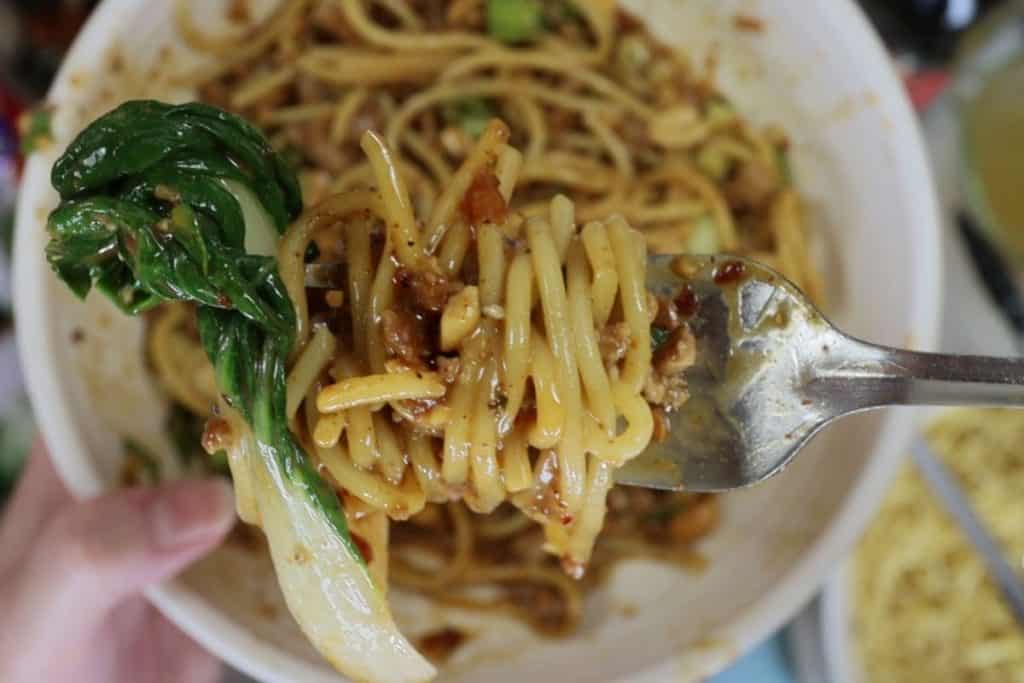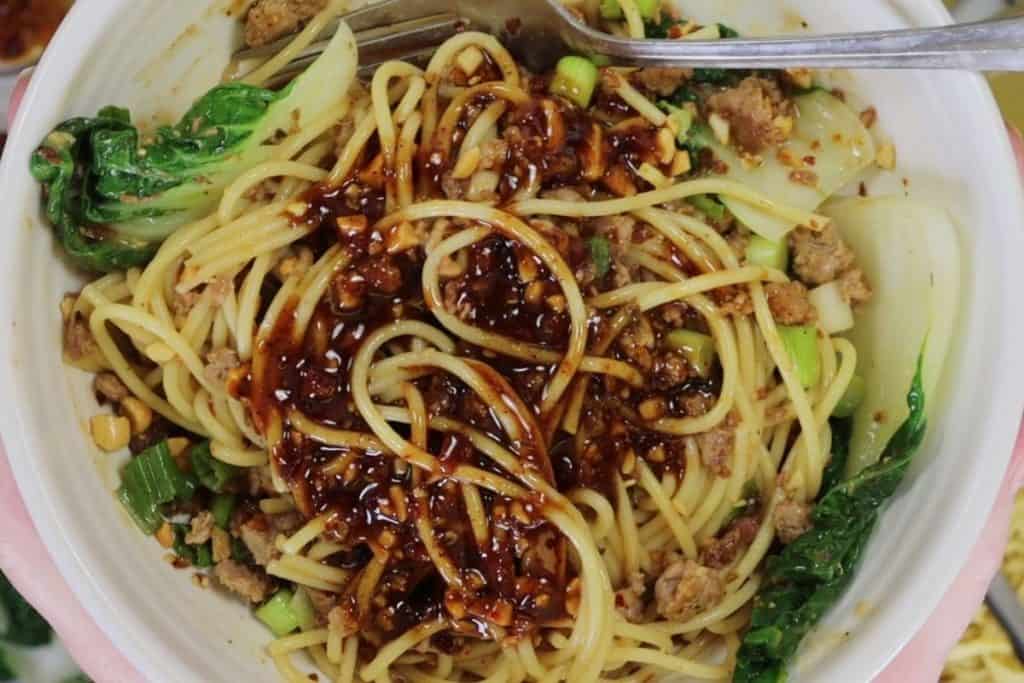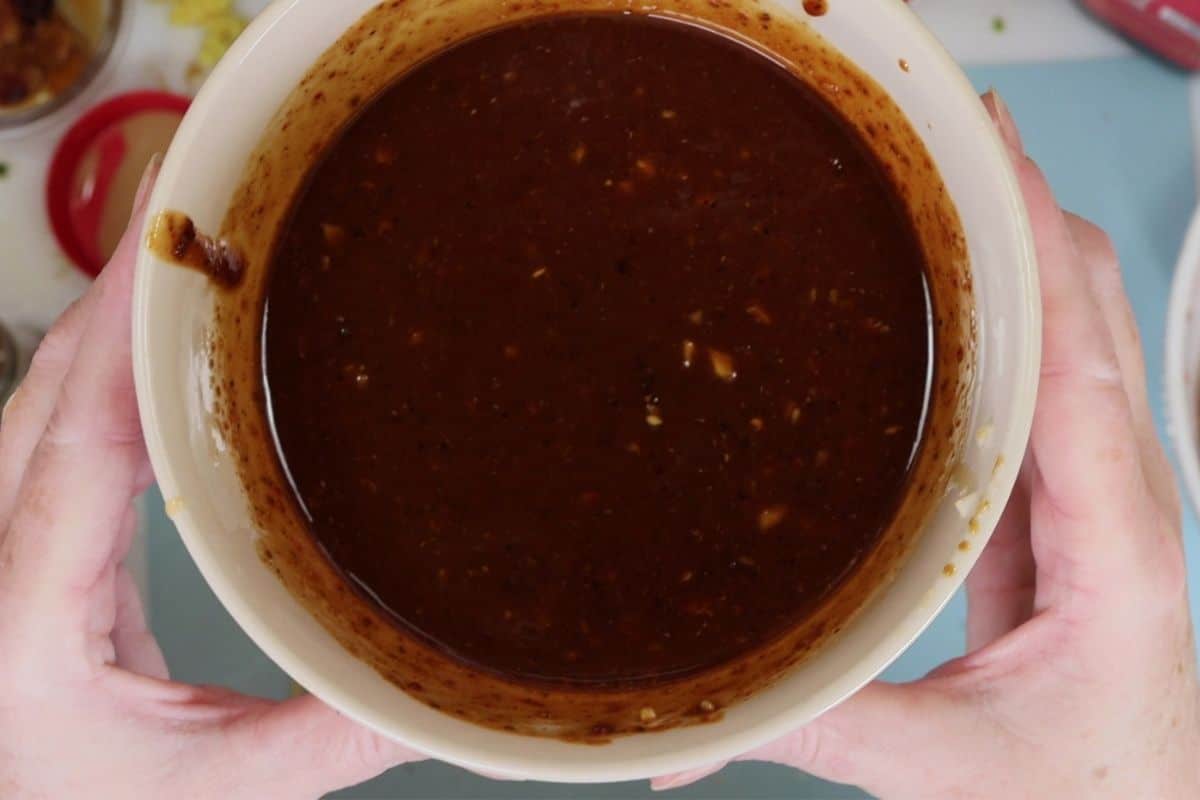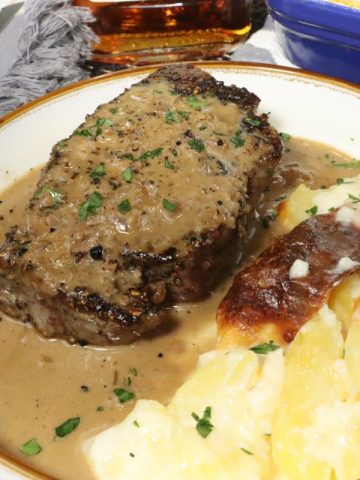
I am so excited to finally post my Dan Dan Noodles recipe. My obsession started a year ago when I stumbled across a recipe online. The pictures were stunning and I was drooling almost immediately. When this happens, I know this is something I need to make. As I Googled Dan Dan Noodles (dandanmian), there were so many versions out there and eventually I decided I needed to start testing my own version.
Dan Dan Noodles Originated in China
This noodle dish comes from Chengdu, which is the capital of the Sichuan Province. The longer name of this noodle dish is dandanmian which translates to "carrying pole noodles" as this is how the vendors carried and sold the noodles as street food. Thank you Wikipedia. When I looked it up on YouTube, I also found a great video by a YouTuber called The Food Ranger. Have you heard of him? I didn't know anything about his channel, but his video sampling Dan Dan noodle places in Chengdu was very exciting to watch. Here is the link if you want to watch it: Dan Dan Noodle Tour in Chengdu.
Here's what I discovered testing this noodle recipe
Let's start with the meat. I noticed that most food sites were using ground pork for this dish, but a few were using ground Italian sausage. Hmmm... I love Italian sausage and thought this sounded awesome. I made them and one thing was very clear: it is simply too salty. The Dan Dan sauce already has soy in it and that's going to give you a punch of salt right off the bat. Using the Italian sausage pushed the salt level over the edge for me. And I love my salt. I'm glad I only made a small batch of that and knew right away: No. It's best with ground pork, but I also think you could use ground chicken too, though I didn't try that myself.

Here's the deal with the noodles. Kind of funny. All the times I tested the recipe, I went to the Asian market and bought fresh, round egg noodles. However, I have discovered you can't keep egg noodles in the fridge too long or they will mold. When you buy them, you need to use them within a few days. Check the package for any dates you can find. Even if you think they are "fresh" they might be old. Case in point: The final fresh noodles I bought to film the video for this were old. I didn't know this. I was in the middle of filming, opened the package and saw the mold. Unfortunately, I didn't have any extra. This is when I discovered that a plain, old box of thin spaghetti works just fine too! Really, the delicious factor was the same.
The Chili Oil and the Dan Dan Sauce
I recently posted a Homemade Chili Oil with Sediment Recipe and you will need chili oil with sediment to make this dish. It's special and it is NOT that clear chili oil you find in the international aisle at your local supermarket. There is sediment at the bottom of the jar. Your brain may be thinking chili oil is too spicy for me. Well, I am here to say that is not necessarily true. You can really and truly make this chili oil as mild or spicy as you want. My chili oil recipe is a mild version for sure. If you want it spicier all you have to do is add more red pepper flakes. That's it.


The chili oil with sediment is one of a handful of ingredients used to make the sauce for the noodles. Most Dan Dan sauces that I researched have the same ingredients, but with varying proportions. So when you're making the sauce remember that you don't have to make it exactly as I have written it. If you want more tahini, add it. Do you think it's too much raw garlic for your taste? Add less. Too much soy - no problem. You can make the version in my recipe, or simply adjust the ingredients to make the sauce that works for you. To be honest, I tried a version of the Dan Dan sauce without the raw garlic and it tasted great too. So, if the raw garlic is freaking you out - don't add it.
Final assembly: mix it all together or individually?
I did it both ways when I was testing this. In terms of presentation, it is lovely to prepare each bowl of noodles individually which is the way I prefer to do it. Put the sauce on the bottom of your bowl, noodles on top, spoon in the ground pork, add the bok choy, scallions, peanuts, and a splash of warm chicken broth (or water). Then each person gets to toss their own noodles. Serve with the additional Dan Dan sauce and the chili oil with sediment on the side. Add more of each if you want! I enjoyed adding a small spoonful of chili oil while I was eating.
The other option is to drain the water from the noodle pot (after you've cooked the bok choy, of course). Put the noodles back in. Pour all the Dan Dan sauce and pork into the pot and mix well. Put noodles in bowls and top with bok choy, scallion, etc... This way works too, but I think it's more fun the other way.
These noodles are so incredibly comforting and addicting. I was really blown away by the flavors. I made this so many times you would think I am sick on them. Nope. Now that I am writing this and posting the video (which I filmed over a month ago), I want to make them again! That's the problem with having a cooking website. I have to look at all the photos and videos throughout the process of publishing this post. Every time - never fails - I want to make that recipe again.
Print
Dan Dan Noodles (dandanmian)
- Prep Time: 25 minutes
- Cook Time: 15 minutes
- Total Time: 40 minutes
- Yield: 4-5 portions 1x
Description
Dan Dan noodles (dandanmian) are insanely delicious and addicting. You can make it mild or spicy - either way - you will not be able to stop eating them!
Ingredients
Ingredients
- 1 bunch of scallions
- 8 baby bok choys
- 1 pound of cooked noodles or thin spaghetti (see note#1)
- Canola oil (or any neutral oil)
- ½ cup chopped peanuts (optional)
- ½ cup warm chicken broth or water (optional)
- Toasted sesame seeds (optional)
For the pork:
- 2 pounds of ground pork
- 3 large cloves garlic, finely diced (1 ½ tablespoons)
- 1 tablespoon grated ginger (2 inches or so)
- 2 ½ tablespoons soy sauce (I use low sodium)
- 3 tablespoons Shaoxing Chinese cooking wine
- ½ teaspoon salt
- ¼ teaspoon pepper
- 2 tablespoons pickled mustard greens (AFTER pork has cooked) see note#6
For the Dan Dan sauce:
- ½ cup chili oil with sediment (see note#2)
- 1 ½ tablespoons dark soy sauce
- 2 tablespoons regular soy sauce (I use low sodium)
- 2 teaspoons ground Sichuan peppercorns
- ¼ cup tahini
- 3 large cloves garlic, finely diced (see note#3)
- 1 tablespoon sugar
Add-ons:
Top with any extra toasted sesame seeds from the chili oil recipe, crushed peanuts, red pepper flakes.
NOTE: Don’t forget to watch my video with all the step-by-step instructions.
Instructions
- You’ll be cooking noodles so start heating your salted water on low at the beginning of the process so that it’s coming to a boil by the time you cook the pork. Should be 1-2 teaspoons of salt in your water.
- Put ground pork in a large bowl.
- Finely dice the garlic and add to the pork bowl.
- Peel and grate the ginger on a microplane. If you don’t have a microplane just mince it with a knife. You’ll need a couple inches of ginger to make a tablespoon depending on the size and shape of the ginger. Add to the pork bowl.
- Add the soy sauce (I use low sodium), Shaoxing cooking wine (very common - get from Asian market), salt and pepper to the pork bowl. Mix everything together well. I found it was easier to do this with my hands than a spoon. After the pork mixture is well blended, let it sit to marinate while you do the other prep work.
- Chop a bunch of scallions, including the white part, and set aside.
- Chop the bottoms off the bok choy and set aside.
- Make the Dan Dan sauce: finely dice the garlic, put ½ cup of chili oil with sediment in a bowl, add dark soy sauce, regular soy sauce (I use low sodium), ground Sichuan peppercorns, Tahini, add the garlic in, and sugar. Whisk to combine.
- Cook the ground pork: Pour a little canola oil in a pan (maybe one tablespoon) and heat on medium. Add the ground pork mixture and chop into smaller bits. You will continuously need to chop the pork up while it’s cooking until it’s in tiny, little bits (video shows this well). Should take about 10 minutes to do this. At the end of cooking, add two tablespoons of the fermented/pickled mustard greens. Mix well with the pork and cook for 1-2 more minutes once added.
- The noodles/pasta: Your salted water should be at a boil when you start to cook the pork. The pasta and the pork take about 10 minutes to cook so add the noodles/pasta to the water when you start the pork. You can use fresh Chinese egg noodles (round) for this or thin spaghetti. Either way is delicious. When the pasta is finished remove with tongs and put in a large bowl. I tossed the noodles with a little olive oil so they don’t stick together. DO NOT THROW THE PASTA WATER AWAY.
- Using the pasta water, cook the baby bok choy. I threw all my bok choy in the water for a minute or two and they were done. Pull the bok choy out with tongs and put in a bowl.
- If you are using the warm chicken broth or water, heat in the microwave now.
- If you’re using chopped peanuts put them in a plastic baggie and smash with a mallet. You can do this at any point in your cooking/prepping process if you are using the peanuts.
- Assemble your bowl of noodles. Dan Dan sauce on the bottom of the bowl (a couple tablespoons or so), noodles on top of that, ground pork, bok choy, scallions, warm chicken broth or water (about 2 tablespoons) and the peanuts and toasted sesame seeds if using. The chicken broth or water is to thin out the sauce a bit so it’s easier for mixing.
Notes
- When I was testing this recipe I bought fresh egg noodles (round) from my favorite Asian market. I purchased them again to film this recipe. However, as I was filming I realized my egg noodles were molded. Luckily, I had thin spaghetti on hand and used that. It really tasted just as delicious using spaghetti. It’s your call here. Linguine would work too.
- Make the homemade chili oil with sediment the day before you are making Dan Dan noodles. When you make chili oil it should sit a day so the flavors develop. You can use jarred/store-bought chili oil with sediment if you already have a favorite.
- The raw garlic for the Dan Dan sauce. If you are not a fan of raw garlic in a sauce add less or omit it altogether. I seldom use raw garlic in something because it can be intense. However, I really loved it in this sauce. If it freaks you out, don’t add it. I tested a version where I didn’t add raw garlic to the Dan Dan sauce and it still tasted totally awesome!
- The optional warm chicken broth or water addition. I liked adding a liquid to thin out the sauce - made it easier to mix and coat all the noodles. If you don’t have chicken broth on hand and are using warm water – don’t use the pasta water. There is salt in the pasta water and you want to watch the salt levels since the Dan Dan sauce has soy sauce which is already salty. If you use pasta water you will likely end up inadvertently over-salting this dish.
- If you want even more Dan Dan sauce just double the recipe for that.
- The fermented mustard greens. I ordered mine on Amazon and the price wasn’t bad. If you can take a picture and show the staff at your local Asian market - they may have it there and you will probably get a better price. However, I noticed at my favorite local Asian market, they make them fresh sometimes and sell them in containers. I had already made this video so I didn’t get them. But next time, I will definitely try that. If you have a local Asian market like this near you and try the homemade fermented/pickled mustard greens let me know!






Leave a Comment